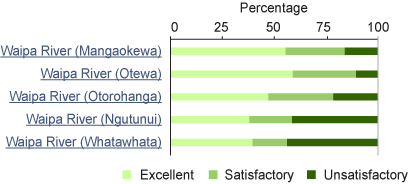How clean is the Waipā River?
Just how good is the water in the Waipā River these days? Is it safe for swimming? Can fish live in it? The answer depends on which part of the river we look at.
- The headwaters of the Waipā River are clear and stained from natual tea-coloured tannins from bush and wetlands.
- Further down the Waipā River the turbidity is worse than the Waikato’s, due to the Waipā catchment’s geology and land use. Also, the Waikato’s hydro lakes trap much of the sediment coming off the upper Waikato catchment.
- Phosphorus levels in the Waipā River are higher than in the upper Waikato River because of geology and land use.
- Nitrogen in the Waipā River is predominantly from farm animals.
Water quality for swimming
Bacteria
Water quality in the Waipā River is generally not always good enough for swimming. Levels of E. coli bacteria (an indicator of health risk) are often above the safe level for swimming.
Levels of E. coli are much lower than they were 60 years ago because of the improvements in sewage and wastewater treatment.
E. coli comes from the dung of farm animals, animals living in the bush, such as pigs and goats, and from birds such as ducks and swans. Municipal sewage, urban stormwater and septic tank and industrial discharges are already regulated and considered to be minor sources.
Clarity
Water clarity in the Waipā River is worse than in the Waikato River, due to different geology and land use. The cloudy, brown headwaters of the Waipā are due to sediment and natural tannins from bush and wetlands. The river’s appearance worsens as it flows through farmland. Sediment adds to the natural tannin to colour the Waipā murky brown.
The river fails contact recreation standards with low clarity.
Water quality for plants and animals

Water quality for ecological health at Waipā River sites (2007-2011)
Water quality is better in the upper reaches of the Waipā River, and is good enough for most aquatic plants and animals to be healthy. The graph shows the percentage of water samples at each site that met our guidelines for water to support aquatic plants and animals (ecological health). Water quality in the lower river is not as good for plants and animals to live in as it is in the upper reaches.
Levels of the nutrients nitrogen and phosphorus, which feed nuisance plants, often do not meet ecological standards in the Waipā River. This reflects the river’s journey through an intensively farmed catchment.
Most nitrogen in the river comes from farmland, mainly cow urine. Nitrogen leaches through the soil and into groundwater. Phosphorus associated with soil washed off farmland is the main source to the river. Check out a pictograph of nitrogen levels and phosphorus levels in the river.




To ask for help or report a problem, contact us
Tell us how we can improve the information on this page. (optional)